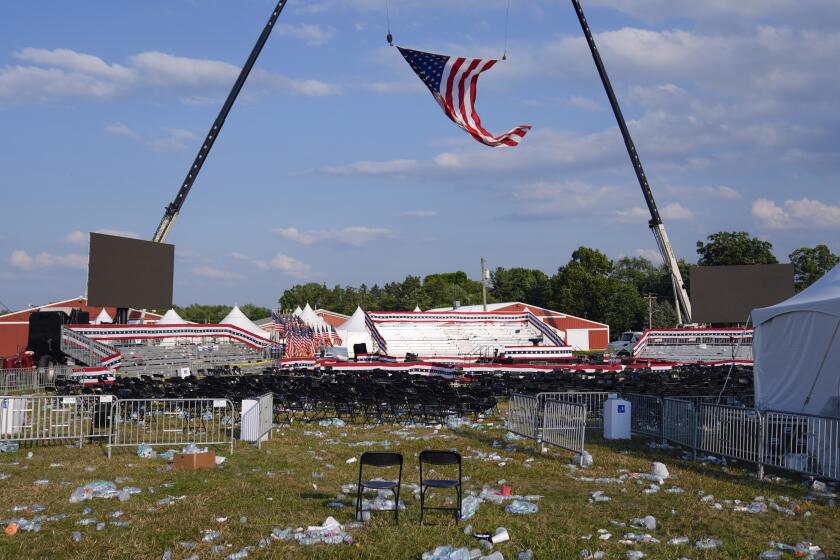‘El Chapo’ Guzman: Life of the cartel king of Sinaloa
MEXICO CITY -- From his naming on the Forbes magazine list of the world’s richest billionaires, to his frequent supposed sightings and magical escapes, Joaquin “El Chapo” Guzman has been a larger-than-life drug lord who reached mythical proportions in Mexican “narco” folklore.
He rose from a simple low-level trafficker from Sinaloa, the cradle of Mexico’s opium and marijuana trade, to become the nation’s most powerful and elusive fugitive.
For Mexicans, the capture of Guzman, reported Saturday to have occurred in a joint operation by Mexican marines and U.S. federal agents in the Sinaloan coastal city of Mazatlan, is somewhat akin to Colombia’s killing of Pablo Escobar -- or even the U.S. elimination of Osama bin Laden.
His luxurious life on the run was the stuff of legend. More than once, he was reported to have entered a fancy restaurant, ordered cellphones confiscated, dined lavishly, then picked up everyone’s check.
PHOTOS: Inside the condo where Joaquin “El Chapo” Guzman was captured
So apparently untouchable was he, that his young beauty queen wife traveled uncontested by authorities to Los Angeles to give birth to twin girls in 2011.
In recent years, Guzman extended the operations of his Sinaloa cartel to an estimated 50 countries across Latin America, Africa and Europe, even hooking up with one of the most notorious Italian mafias, the ‘Ndrangheta.
“This gives us the dimension of who was ‘El Chapo’ Guzman,” said Jose Reveles, author of several books on Mexican drug-trafficking.
Given Guzman’s folk hero status, the constant rumors of his presence across borders and time zones, and his ability to bribe local officials to look the other way, it was difficult for some officials not to accord Guzman a grudging respect.
Guillermo Valdes, the former head of Mexico’s National Security and Investigation Center who authored a book on his country’s drug trade, called Guzman an exceptional leader -- a “business genius.”
“I think that ‘El Chapo’ is a person with a leadership capacity and a strategic vision that the other narcos don’t have, and they recognize that,” Valdes told the Spanish newspaper El Pais. “He’s a very intelligent person, with a great capacity for listening. With a great ability to seduce people, as well as a large imagination ... and creativity.”
The U.S. government offered a reward of up to $5 million for information leading to his arrest. The Mexican government was offering a reward of 30 million pesos, or about $2.3 million. There were many reported near misses, including a supposed appearance in Baja California in 2012, days before Secretary of State Hillary Clinton was in the region.
There is some disagreement over Guzman’s actual birth date, but the U.S. State Department puts it at Dec. 25, 1954, making him 59 years old. Interpol lists him as 56. The U.S. government lists him at 5-foot-8 and 165 pounds, but others say he is about 5-foot-6, hence his nickname “El Chapo,” or “Shorty.”
To many Mexicans, guessing Guzman’s whereabouts had become a popular and macabre parlor game -- a kind of cartel “Where’s Waldo?” Mexican security officials, meanwhile, conducted numerous searches in vain, contributing to the mystique of bad man as wily trickster--and burnishing his reputation as a folk antihero.
A popular narcocorrido, or song glorifying the drug world, by a Mexican group called Los Buitres (The Vultures), captured the life that so many here assumed Guzman was living and the legend that had grown up around him:
He sleeps at times in homes
…at times in tents
Radio and rifle at the foot
of the bed
Sometimes his roof is a cave.
Guzman does seem to be everywhere.
Many other Mexicans not seduced by Guzman’s outlaw image still believed that the Sinaloa cartel was a “businesslike” operation that didn’t prey upon innocents as much as other cartels like the Knights Templar, famous for its extensive extortion racket in the state of Michoacan; or the Zetas gang, which has terrorized regular people with extortion, kidnapping, human trafficking, and which has a penchant for killing that seems, at times, to be unmoored from any sort of human scruples.
Yet it was Guzman’s decision to move into territory controlled by those other groups that led to some of the most bloody fighting in the last three years in states that had until then been relatively peaceful.
Guzman was born in Badiraguato, an isolated municipality in Sinaloa, the Pacific Coast state notorious for its untameable badlands and multi-generational web of drug producers and smugglers. He grew up poor, working on his grandfather’s farm, and was reportedly adamant about never returning to the life of a Mexican peasant.
A former mistress, Zulema Hernandez, told writer Julio Scherer long ago that Guzman was kicked out of the house by an abusive father. He is believed to have left school after the third grade.
Like many in Sinaloa, Guzman had family members with connections to the drug trade. In his case, it was Pedro Avila Perez, a founder of the Sinaloa cartel, which had long grown and distributed Mexican marijuana and heroin, but by the 1980s branched out into smuggling Colombian cocaine into the U.S.
Guzman got his start overseeing drug production on local farms. He then began handling the planes, boats and trucks used to smuggle the South American cocaine into Mexico.
By 1989, deaths and arrests, plus good luck and ambition, had put Guzman and his cousin, Hector Palma, at the top of the cartel sector that moved as much as 24 tons of cocaine into the U.S. each month. But Guzman’s power was challenged by a faction led by the Arellano Felix family, based in Tijuana. Guzman sent dozens of gunmen to attack the Arellanos at a party in Puerto Vallarta in 1992, killing nine people.
Less than a year later, the Arellanos sent gunmen to ambush Guzman at the Guadalajara airport, but instead killed the cardinal of Guadalajara, Juan Jesus Posadas Ocampo. Much about the shooting remains unclear, but one theory holds that the bishop was mistaken for Guzman.
The death of the bishop sent shock waves throughout Mexico and beyond. The Mexican government had long been viewed as lax in its punishment of drug lords, if not occasionally complicit with them, particularly with Guzman, who was said to enjoy protection from some of the country’s top law enforcement officials.
Public pressure forced the government to crack down. Guzman was arrested in Guatemala a couple of weeks after the shooting.
He was transferred to a maximum security federal prison in Guadalajara, where he lived comfortably. But when faced with extradition to the U.S., he apparently decided to flee.
On Jan. 19, 2001, according to the State Department, Guzman escaped from the prison “allegedly with the assistance of prison officials.”
The U.S. government summarized the next chapter of his life bluntly: “While on the run from Mexican authorities,” says the official profile on the State Department’s Narcotics Reward Program website, “Guzman-Loera has reestablished himself as a high-ranking member of the Mexican drug trade.”
He emerged, apparently, as a wiser, battle-tested chief executive eager to prove he was still on top of his game. As the Mexican federal government got more serious about fighting the drug war, Guzman relied more on corrupt local officials for protection. He created a mobile stealth operation and probably benefited from the largess of wealthy Colombian traffickers who saw his operation as the most stable and well-managed of the Mexican cartels.
In the late 1990s, he is believed to have added methamphetamine to the Sinaloa gang’s portfolio, arranging the shipment of precursor chemicals from Asia to Mexico’s Pacific Coast, and setting up mega-labs for meth production throughout rural Mexico.
Guzman’s unbridled ambition and lust for expansion brought predictable, and tragic, clashes with other big-money, big-ego drug lords. That was a key driver of the bloody nightmare that plagued the country during the six-year term of Mexican President Felipe Calderon, from 2006 to 2012, and continues to plague it, to some extent, today.
Guzman’s desire to control the drug transit route through the city of Juarez was the likely reason for the 2004 assassination of Rodolfo Carrillo Fuentes, the head of the Juárez cartel, which had formerly lorded over the city. The slaying unleashed a long and bloody struggle for that city. Guzman would later clash with his former allies in the Beltran Leyva drug organization, and engage in a brutal war for territorial control with the paramilitary drug group known as the Zetas.
The fight to stay at the top came at a tremendous personal cost for El Chapo. Year after year, friends, family and associates were killed by drug-world rivals, or in shootouts with police and the military, or arrested and sometimes extradited to the United States.
The prize was unfathomable wealth, and an empire that extended into hundreds of U.S. cities, and into lucrative drug markets in Europe and Asia. His influence, it seemed, was everywhere: In February of last year, the Chicago Crime Commission declared Guzman to be “Public Enemy No. 1,” for the drugs he was believed to be pumping into the crime-ridden metropolis, even though he probably never set foot in the place.
richard.fausset@latimes.com
wilkinson@latimes.com
Cecilia Sanchez of the Times’ Mexico City bureau contributed to this report.
More to Read
Sign up for Essential California
The most important California stories and recommendations in your inbox every morning.
You may occasionally receive promotional content from the Los Angeles Times.











